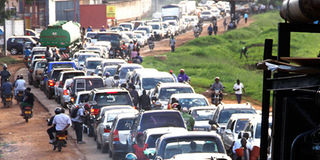Prime
Traffic jam eating into people’s working hours

Standstill. Motorists stuck in a heavy traffic jam on Mukwano Road in Kampala. PHOTO BY ABUBAKER LUBOWA.
What you need to know:
- Part of life. Lately, one’s life is planned around the traffic jams which continue throughout the day until evening and cross into the night.
Kampala. Majority Ugandans’ aspiration immediately they begin earning an income is to buy a car to gain some status in society.
Many, however, forget that Kampala is a single-centred city flocked by Ugandans that use both private and public means in the hope of attaining better services, hence contributing to the heavy traffic jam.
The city was designed to cope with about 45,000 vehicles, yet those that enter the city daily are more than two million, including taxis and private vehicles, according to Kampala Capital City Authority (KCCA).
Lately, one’s life is planned around the traffic jams which continue throughout the day until evening and into the night.
People now sit on the roads for hours every day, encroaching on the time they are to report for work.
With the unpredictable heavy jam, some spend several hours moving to a destination less than a kilometre away.
Traffic police officers are always on alert, controlling traffic flow whether or not signal lights are working.
Ms Joan Nansubuga, 32, a mother of two, for instance, is a bank teller who resides in Matugga in Wakiso District, but has to juggle through the heavy jam in order to make it to office in time. Matugga to the city centre is a distance of 18kms, which should ideally be less than 40 minutes’ drive.
However, she spends several hours on the road, something she says, leaves her exhausted, leading to less concentration at work.
“I bought land and built a house in Matugga because we wanted a cheap but accessible land. I wake up by 5pm, I find myself leaving home at 7am because I have to prepare my children for school. Although I am supposed to be at office by exactly 7:30am, I at time get late by either 30 minutes or one hour depending on the traffic of the day,” she says.
Ms Nansubuga explains that the situation becomes worse in the evening. Although she leaves work by 6pm, she gets home after 8pm because of the heavy traffic jam on Bombo Road.
She pays Shs2,000 for taxi charges from Kampala to Matugga.
Her traffic jam ordeal is shared by many people, especially those who live in the outskirts of Kampala, but work in the city.
For instance, Mr John Stuart Nsamba, a super market manager in the city, says the heavy traffic jam on Jinja Road is unbearable because it takes most of people’s time that use the same road.
“I am always up by 5:30am and l set off by 7am. However, I am always late by an hour at work because of the congestion on Jinja Road. When it comes to evening hours, the story becomes worse because I normally set off from town at 7pm but get to Seeta [in Mukono District] at around 9:30,” he says.
Kampala to Seeta is about 17.7kms.
Mr Nsamba has to work for eight hours per day. This translates into 40 hours per week, and 160 hours per month. However, for every hour that he loses in traffic jam while going for work, it translates into 5 hours per week and 20 hours per month.
What is causing this jam?
Dr Amin Tamale Kiggundu, a senior lecturer of Urban Planning at Makerere University, attributes the heavy traffic jam on the city’s poor physical planning, which he says continues to affect people.
“Kampala is a single-centred city yet many countries are now moving towards establishing a multi-sectoral system. When you look at Kampala, most of the services are in the city centre. There is no way congestion could be contained if alternative cities are not opened up in other city outskirts,” he says.
According to statistics from KCCA, the city has a day population of 4.5 million people and a night population of 1.5 million people.
Although KCCA is planning to operationalise the Kampala Metropolitan Physical Planning Authority (MPPA), which would perhaps enable them to create more satellite cities, the plan is still rotting away on the shelves, waiting for government approval.
If approved, Wakiso, Mukono and Mpigi would be part of Kampala city. The idea is to create as many city centres as possible to extend services near the people.
Dr Kiggundu also blames the heavy congestion in the city on government’s failure to control the transport system.
He says the transport system in the city has been left at the hands of the private investors, hence the increasing number of commercial vehicles but with low sitting capacity.
“Government should now embrace the use of buses and railway as a public means of transport because they have a very big sitting capacity compared to these taxis in the city yet they carry very few passengers,” he says.
He also says the city’s road network is poor, making it vulnerable to heavy traffic jam as there are no ring roads that could be used as alternatives, especially during rush hours.
Of the 2,000kms of roads in the city, only 500kms are tarmacked. The potholed roads become an uphill task for drivers to reach their destinations on time.
Too many cars
Statistics from KCCA further show that there are 14,000 taxis operating in the city. This number, coupled with that of the private car owners, leaves the city congested, making people lose many hours in traffic.
Although many people would love to live near their workstations in the city centre, the high rental fees doesn’t allow them. As a result, they save their money and build houses in the outskirts of the city.



